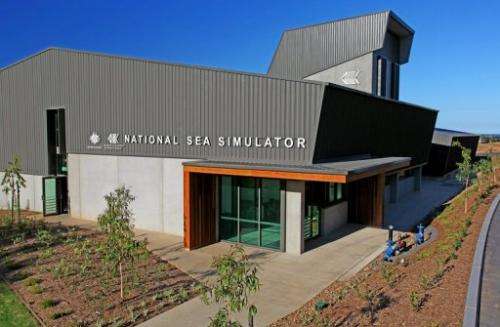Australia opens 'world's smartest' aquarium

A major research aquarium able to simulate ocean warming and carry out key studies on the deadly crown-of-thorns starfish devastating the Great Barrier Reef opened in Australia on Thursday.
The Aus$35 million (US$31.4 million) National Sea Simulator, or SeaSim, was unveiled in the northern city of Townsville by Industry Minister Kim Carr, who said it was a vital weapon in protecting the reef and Australia's vast territorial waters.
The Australian Institute of Marine Science (AIMS), where SeaSim is housed, has labelled it as the "world's smartest aquarium". It has an "awesome" array of technology on offer, according to AIMS principal research scientist Mike Hall.
"When we started planning SeaSim we visited over 40 marine aquariums around the world to identify key attributes of the perfect research facility," said Hall.
"What we've built takes the best in the world and adds new technologies and an incredible level of automation and control."
Hall said researchers would be able to tweak a sophisticated array of parameters in the SeaSim tanks, including water temperature and acidity, salinity, lighting, nutrient levels, and water quality to test a range of hypotheses.
"It still has walls, unlike the open ocean. But it will fast-track marine discovery," he said.
Tackling the predatory crown-of-thorns starfish responsible for widespread damage to the Barrier Reef would be a key priority for the simulator, according to AIMS chief John Gunn.
Coral cover on the embattled reef—which is facing a world heritage downgrade from UNESCO—has halved in the past 27 years, with the starfish blamed for 42 percent of the damage.
"We need to understand why starfish populations periodically boom leading to massive reef destruction. Is it due to nutrients in flood waters or are more complex factors at play?" said Gunn.
He said the coral-feasting starfish were known to communicate via chemical signals, and SeaSim would explore whether those same signals could be replicated to "trick starfish into congregating or dispersing—making physical removal easier".
"We hope to answer these and many other questions about the starfish with the help of SeaSim," he said.
The Australian government has funded a culling programme for the coral predators, which are naturally-occurring but have proliferated due to pollution and run-off.
Canberra formally downgraded the reef's health from moderate to poor last month, with cyclones and floods depleting water quality and reducing coral cover by 15 percent since 2009.
SeaSim will also explore the mechanisms of coral bleaching and how the reef may adapt to warmer, more acidic oceans, with long-term, multi-organism and multi-generational studies possible on a larger scale than ever before possible.
© 2013 AFP


















